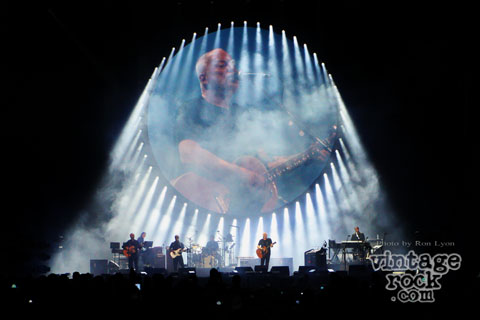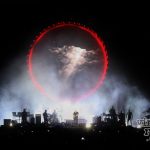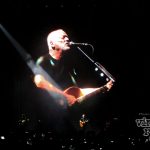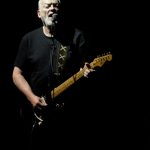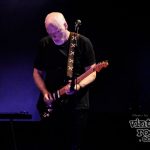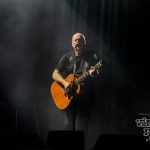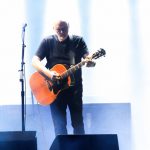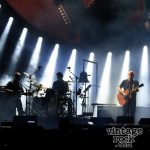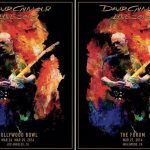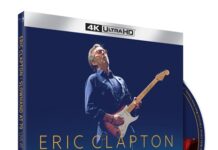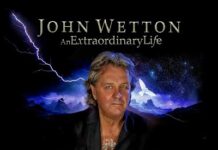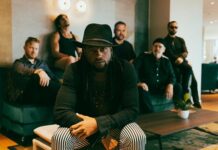Review by Shawn Perry
Photos by Ron Lyon
It’s becoming ever more apparent that many of our musical heroes are aging and fading into the scenery (or as 2016 has proven, passing away at an alarming rate). This is why it’s vital to covet those who are still among us. Neil Young, Paul McCartney, the Rolling Stones and Bob Dylan are as active as ever, still touring, still in the press, even still making records — even though no one is buying them anymore. Innumerable others are scrapping by, their best years behind them, finding opportunities on the fair, casino and corporate circuits to keep the show afloat. And then there’s the case of David Gilmour.
As one of the principals of Pink Floyd, Gilmour has the fame, fortune and prestige to work when and how he chooses. For a few years after 1995, when Pink Floyd was more or less laid to rest, the guitarist kept a low profile, becoming a family man and champion of various causes and movements. His absence from the airwaves left many wondering, myself included, if he had simply retired from playing music and living a public life.
In 1999, he turned up for a show with Paul McCartney at the Cavern in Liverpool, and in the early 2000s, he played a few low-key acoustic shows in London and Paris. Then in 2005, seemingly out of the blue, Gilmour joined Nick Mason, Rick Wright and longtime nemesis Roger Waters for the Pink Floyd reunion at Live 8. Perhaps what struck everyone was that despite Gilmour’s graying, receding hairline and extra paunch, he could play guitar and sing as well as he did during his prime. Indeed, the voice and tone were very much intact.
The next year, he issued his first solo album since 1984, On An Island, and hit the road for a world tour, including a stop at the now-defunct Gibson Amphitheatre where yours truly was in attendance. Even though Pink Floyd was history, the shows were as close as you could expect to get to the real deal, covering mandatory staples like “”Wish You Were Here” and “Comfortably Numb,” alongside deeper cuts like “Fat Old Sun” and “Echoes.” Rick Wright joined Gilmour for what turned out to be his last tour before passing away in 2008.

After the On An Island tour, Gilmore made a handful of random concert appearances, including a couple with Roger Waters, collaborated with The Orb for 2010’s Metallic Spheres, and teamed up with Nick Mason to piece together 2014’s Endless River, Pink Floyd’s final album. That likely planted the seed for Rattle That Lock, followed by shows in Europe and South America in late 2015. A four-city North American tour was announced for 2016 and the first stop on the itinerary was none other than the Hollywood Bowl, a venue Gilmour hadn’t played since 1972. Naturally, I bought a pair of tickets.
It sold out quickly so a second show was added. Then a third at a different LA venue, the Forum. A similar strategy took place in Toronto, Chicago and New York. Making it to the Forum would be easier for me, but seeing the opening U.S. date at the Hollywood Bowl was an alluring proposition. There was only one solution: Go to both. In the end, I was glad I did because what I saw were two distinctly different shows in terms of the visuals and vantage point. The setlist, on the other hand, remained the same, which was fine with me.
Unlike many of his peers, Gilmour has no reservations about playing his new music live, and so he began the show with three songs from Rattle That Lock — “5 A.M.,” “Rattle That Lock” and “Faces of Stone.” Once that tone breaks through, Gilmour can play just about anything and people will melt into pools of ecstasy, and that’s exactly what he did at both the Hollywood Bowl and Forum shows.
My seat at the Forum was perfect for watching the band up close, while the Hollywood Bowl offered customized visuals. Essentially, the prominent arch in front of the venue’s famous shell served as an additional backdrop for the light show, incorporated to great effect. During “Money,” coins fell from the columns and spilled down each side of the arch. “Astronomy Domine” was saturated with enough psychedelia to make anyone feel like they were on some sort of cosmic acid trip.
Also unique to the Hollywood Bowl was an appearance by David Crosby, who came up and sang along on “A Boat Lies Waiting,” “The Blue,” “On An Island” and “Comfortably Numb.” In 2006, both Crosby and Graham Nash showed up for Gilmore’s LA show, but relations between the two longtime band mates is presently strained. At any rate, Crosby gave a whole new meaning to Roger Waters’ part on “Comfortably Numb,” as did David Bowie, Robert Wyatt and virtually anyone else who has stepped up to sing the song with Gilmour. At the Forum, keyboardist Jon Carin actually sang the part as close to the original as anyone I’ve heard.

The Forum show was indeed lighter on the eye candy, but the ever-present round backdrop was filled with video, both live and produced. “Wish You Were Here,” in its stark barrenness, provided a blanket of intimacy. Audiences at both venues were also treated to a stream of lasers that shrouded Gilmour during his climatic solo at the end of “Comfortably Numb.” That alone easily lured the first 30 rows into a hypnotic trance.
As in 2006, Gilmour was once again joined by Carin, bassist Guy Pratt, drummer Steve DiStanislao and guitarist Phil Manzanera. New players for this tour include keyboardist Kevin McAlea, saxophonist João de Macedo Mello, and backing vocalists Lucy Jules, Louise Clare Marshall and Bryan Chambers. By all accounts, the same lineup is to accompany Gilmore for all the North America dates through April 11. A summer tour is scheduled in Europe with additional fall dates in the UK. In all likelihood, this could be the very last time Gilmour tours the States.
If that’s the case, then going to both shows was really the only option I had. I have no qualms about flying to London to see him again, but practicality intervenes and duty calls and the last thing anyone can do is fly around the world, following David Gilmour. But who knows. The tone is all there, the voice no less powerful — maybe David Gilmour will defy time, as he seemed to when he played “Time,” and return to these shores. When you’re entranced by the space-time continuum sway of the music, anything seems possible.



